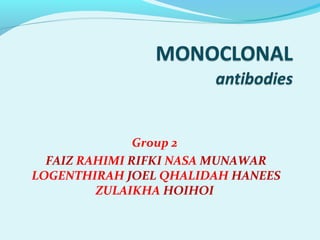
monoclonal antibodies
- 1. Group 2 FAIZ RAHIMI RIFKI NASA MUNAWAR LOGENTHIRAH JOEL QHALIDAH HANEES ZULAIKHA HOIHOI
- 2. History of mAb development 1964 Littlefield developed a way to isolate hybrid cells from 2 parent cell lines using the hypoxanthine-aminopterin-thymidine (HAT) selection media. 1975 Kohler and Milstein provided the most outstanding proof of the clonal selection theory by fusion of normal and malignant cells 1990 Milstein produced the first monoclonal antibodies logen
- 3. Paul Ehrlich at the beginning of the 20th century theorized that a cell under threat grew additional side-chains to bind the toxin, and that these additional side chains broke off to become the antibodies that are circulated through the body. It was these antibodies that Ehrlich first described as "magic bullets" in search of toxins. logen
- 4. Beginning of Monoclonal Era Georg Kohler and Cesar Milstein fuse mouse lymphocytes with neoplastic mouse plasma cells to yield hybridomas that produce specific antibodies. This offers a limitless supply of monoclonal antibodies. Monoclonal antibodies permit diagnostic tests that are specific, and function as probes. rahimi
- 5. Discovery of Monoclonal Antibodies Monoclonal antibodies were produced in mice using a technique described by Köhler and Milstein et al.. They were awarded the Nobel Prize in 1984 (along with Jerne) for their work. rahimi
- 6. Nobel prize in Medicine and Physiology was awarded to Köhler, Milstein and Jerne in 1984
- 7. The structure of antibodies http://www.path.cam.ac.uk/~mrc7/igs/mikeimages.html nasa
- 8. What are antibodies? An antibody is a protein used by the immune system to identify and neutralize foreign objects like bacteria and viruses. Each antibody recognizes a specific antigen unique to its target. Monoclonal antibodies (mAb) are antibodies that are identical because they were produced by one type of immune cell, all clones of a single parent cell. Polyclonal antibodies are antibodies that are derived from different cell lines. They differ in amino acid sequence. nasa
- 9. Characters of Monoclonal Antibodies Monoclonal antibodies (mAb) are a single type of antibody that are identical and are directed against a specific epitope (antigen, antigenic determinant) and are produced by B-cell clones of a single parent or a single hybridoma cell line. A hybridoma cell line is formed by the fusion of a one B-cell lymphocyte with a myeloma cell. Some myeloma cells synthesize single mAb antibodies naturally qhalidah
- 11. Hybridoma creates Monoclonal antibodies Monoclonal antibodies are typically made by fusing myeloma cells with the spleen cells from a mouse that has been immunized with the desired antigen. However, recent advances have allowed the use of rabbit B-cells. hanees
- 12. Principles in Hybridoma technology inject the protein into a mouse. - remove the spleen. - identify which spleen cells are producing antibodies. - separate these cells and grow in tissue culture tubes. - screen each Ab for cross reactivity. - select the Ab which doesn't cross react with any other protein. Zulaikha
- 13. Monoclonal antibodies are produced by Hybridoma technique
- 14. Monoclonal – Diagnostic use Although monoclonal antibodies were first produced in 1975 as research tools, scientists quickly recognized their practical uses, especially in diagnostic tests and in therapy. Several diagnostic procedures that use monoclonal antibodies are now available rifqi
- 15. A breakthrough in Diagnostics A monoclonal antibody can be used to detect pregnancy only 14 days after conception. Other monoclonal antibodies allow rapid diagnosis of hepatitis, influenza, herpes, streptococcal, and Chlamydia infections. rifqi
- 16. Helps in Critical Diagnostic decisions They can be used to detect for the presence and quantity of this substance, for instance in a Western blot test (to detect a substance in a solution) or an immunofluorescence test. rifqi
- 17. Monoclonal's helps In Immunodiagnostic tests Monoclonal antibodies can also be used to purify a substance with techniques called immunoprecipitation and affinity chromatography. joel
- 18. Limitations with Mouse Monoclonals Problem in medical applications is that the standard procedure of producing monoclonal antibodies yields mouse antibodies, and these are rejected by the human immune system
- 19. Finding solutions for Human use In one approach, one takes the DNA that encodes the binding portion of monoclonal mouse antibodies and merges it with human antibody producing DNA, in order to make bacteria produce antibodies that are half mouse and half human.
- 20. Conjugated monoclonal antibody therapy: Toxins or radioactive isotopes are bound to the constant region of the MAbs. When the MAb binds to the surface cells of a tumor the toxin or radioactivity will kill the cancer cells and all cells within a certain radius (a killing zone). In this way cancer cells within the tumor will be killed Cheah
- 21. Monoclonal antibodies for cancer treatment Possible treatment for cancer involves monoclonal antibodies that bind only to cancer cells specific antigen and induce immunological response on the target cancer cell (naked antibodies). mAb can be modificated for delivery of [toxin], radioisotope, cytokine.
- 22. Possible side effects of monoclonal antibodies Monoclonal antibodies are given intravenously (injected into a vein). Compared with the side effects of chemotherapy, the side effects of naked mAbs are like an allergic reaction. These are more common while the drug is first being given. munawar
- 23. Possible side effects can include: Vomiting Diarrhea Low blood pressure Rashes
- 24. Some mAbs can also have other side effects that are related to the antigens they target. For example, bevacizumab (Avastin®), an mAb that targets tumor blood vessel growth, can cause side effects such as high blood pressure, bleeding, poor wound healing, blood clots, and kidney damage.
